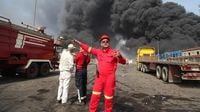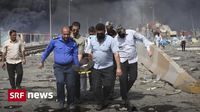A devastating explosion rocked the Port of Schahid Radschai in Bandar Abbas, Iran, on Saturday, April 26, 2025, resulting in a tragic loss of life and significant injuries. According to state media, the death toll has tragically risen to 28, with over 800 individuals reported injured, many suffering severe wounds. Six people are still unaccounted for, raising concerns as rescue efforts continue.
The explosion, which originated in a chemical storage facility, sent shockwaves felt up to 50 kilometers away, causing extensive damage to the port infrastructure. Eyewitness accounts described towering black smoke billowing into the sky, a grim testament to the explosion's ferocity. The Iranian government has launched an investigation into the incident, with President Massud Pezeshkian ordering a thorough inquiry to determine the cause.
Initial reports suggest that the explosion was triggered by improper handling of flammable materials. A spokesperson from the Iranian disaster control agency indicated that chemicals in containers were likely responsible for the blast. A representative from the Iranian Revolutionary Guards mentioned that sodium perchlorate, a chemical used in rocket construction, may have exploded, although the government has been cautious in confirming the exact cause.
In the aftermath, the Iranian Interior Ministry has dismissed speculation linking the explosion to ballistic missile fuel, asserting that such claims are influenced by the country’s adversaries. The ministry emphasized that no military goods were present in the vicinity of the port. Meanwhile, the local crisis manager reported that multiple containers exploded at the quays, leading to a massive fire that the fire department has since managed to control, extinguishing about 90 percent of the flames.
The Port of Schahid Radschai is a vital economic hub, handling more than a third of Iran's sea trade, which translates to approximately 70 million tons of goods annually. It serves as a critical link for maritime commerce, connecting Iran to 80 international ports and 21 shipping lines. The port’s strategic importance cannot be overstated, as it plays a crucial role in the Iranian economy.
In light of the tragedy, the Iranian government has mobilized resources to assist the victims. Local hospitals are overwhelmed with patients, and the entire province of Hormusgan has been urged to donate blood to help those severely injured. Reports indicate that 27 of the injured individuals required surgical intervention, highlighting the explosion's devastating impact on the community.
Internationally, Russian President Vladimir Putin has extended offers of assistance to Iran following the explosion, expressing condolences for the loss of life. This gesture underscores the global concern regarding the incident and hints at the potential for international collaboration in the recovery efforts.
The explosion at Schahid Radschai is not an isolated incident; it follows a series of industrial accidents in Iran, including a notable coal mine explosion in Tabas in September 2024 that claimed over 50 lives. These recurring tragedies have raised questions about safety protocols and the handling of hazardous materials within the country.
As investigations continue, the Iranian government faces pressure to provide answers to the public and the families affected by this disaster. The call for accountability and improved safety measures has intensified, with many citizens demanding a thorough review of current practices in hazardous material management.
Amidst the chaos, the local community has shown resilience, coming together to support one another in the wake of this tragedy. The port's operations have been temporarily suspended, and officials are assessing the damage to determine the next steps for recovery.
While the immediate focus remains on rescue and recovery efforts, the long-term implications of the explosion may lead to significant changes in safety regulations and emergency response protocols within Iran. The incident serves as a stark reminder of the potential dangers associated with industrial operations and the need for stringent oversight.
As the dust settles and the investigation unfolds, the people of Bandar Abbas and the wider Iranian community are left to grapple with the aftermath of this catastrophic event. The hope is that lessons learned will pave the way for safer practices in the future, preventing such tragedies from occurring again.






